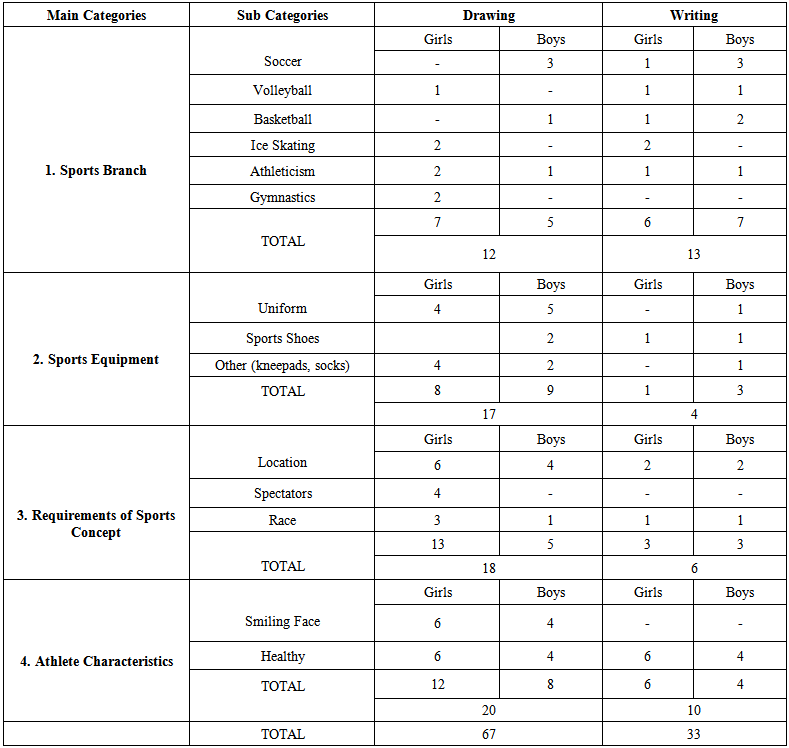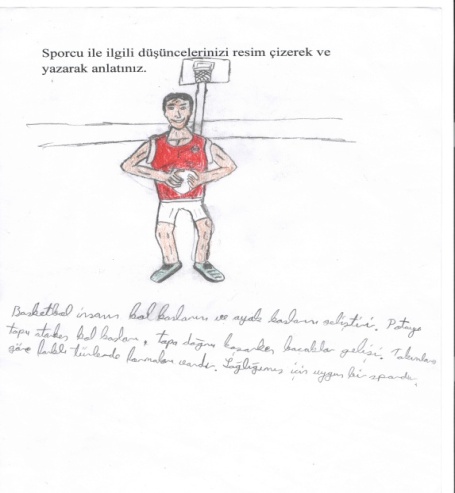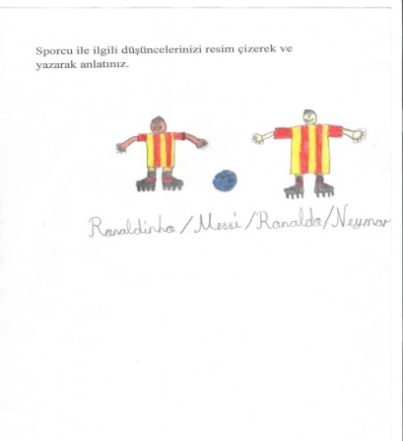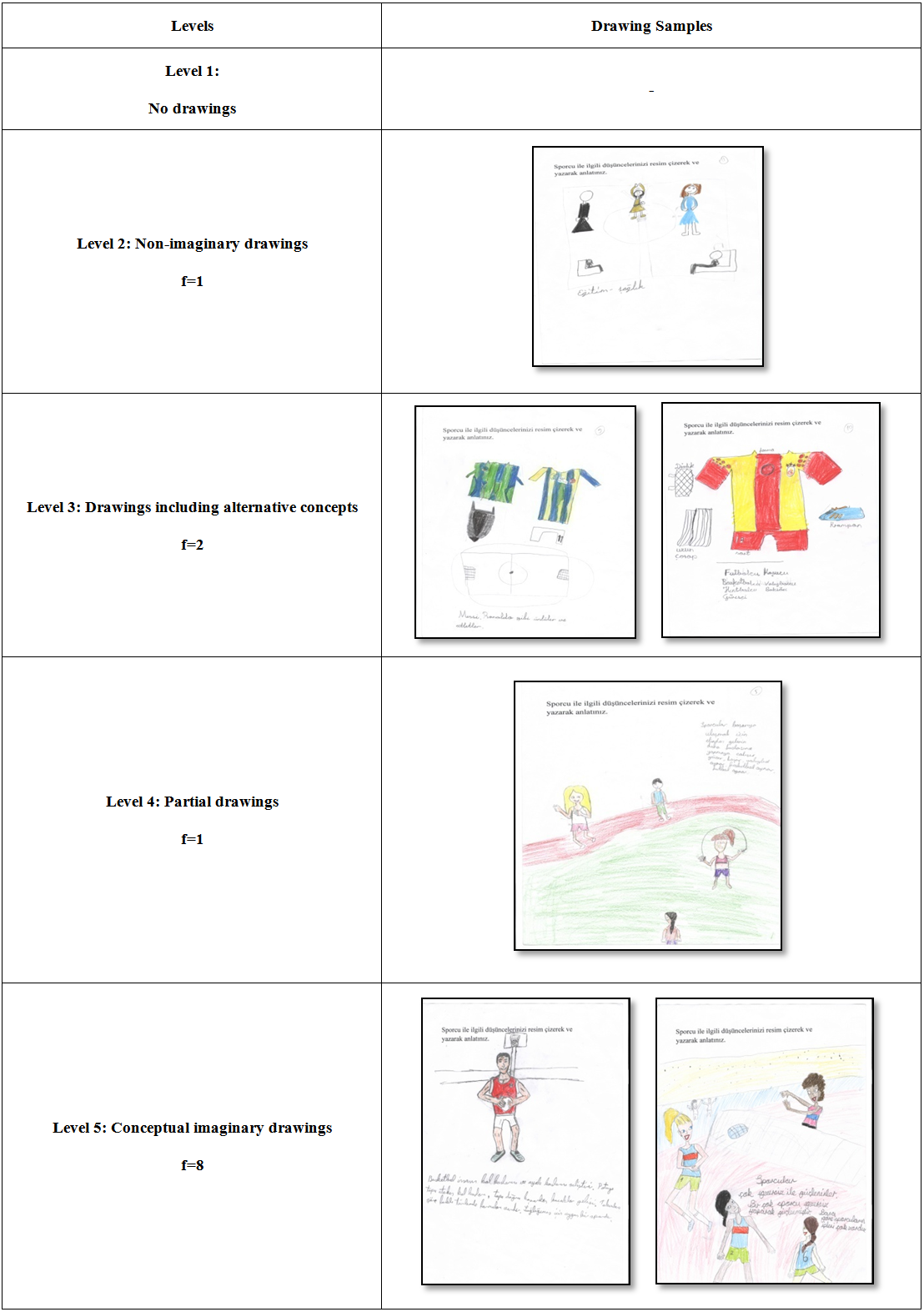-
Paper Information
- Next Paper
- Previous Paper
- Paper Submission
-
Journal Information
- About This Journal
- Editorial Board
- Current Issue
- Archive
- Author Guidelines
- Contact Us
International Journal of Sports Science
p-ISSN: 2169-8759 e-ISSN: 2169-8791
2015; 5(4): 156-161
doi:10.5923/j.sports.20150504.07
A Qualitative Study on Athlete Perceptions of Elementary School Students
Emre Ozan Tingaz
Gazi University, School of Physical Education and Sports, GaziMahallesi, AbantSokak, Ankara, Turkiye
Correspondence to: Emre Ozan Tingaz, Gazi University, School of Physical Education and Sports, GaziMahallesi, AbantSokak, Ankara, Turkiye.
| Email: |  |
Copyright © 2015 Scientific & Academic Publishing. All Rights Reserved.
The purpose of this study is to examine cognitive structures of elementary school students on “athlete perceptions” by using the drawing-writing technique. Moreover, clarification of alternative conceptions of sports will be attempted. This investigation was conducted by using a phenomenology pattern, which is one of qualitative research methods. Study group of the investigation is made of a total of 12 elementary school students, 6 of which is girls and 6 is boys in 3rd and 4th gradesin Gazi University Foundation Private Schools. The drawing-writing technique, one of qualitative research approaches, was used in the study. In conclusion, it was determined that the athlete perceptions of the elementary school students were close to the truth. However, it can be stated that perceptions of the girls in the drawing area were more correct in comparison to the boys. In the writing area, on the other hand, it was concluded that the athlete perception of the boys was focused on sports branch primarily.
Keywords: Primary School, Athlete Perception, Drawing-writing Technique
Cite this paper: Emre Ozan Tingaz, A Qualitative Study on Athlete Perceptions of Elementary School Students, International Journal of Sports Science, Vol. 5 No. 4, 2015, pp. 156-161. doi: 10.5923/j.sports.20150504.07.
Article Outline
1. Introduction
- Various definitions and opinions have been presented about sports. The reason behind it is that scopes, branches, aims, contents and performance types have been perceived and evaluated differently (Yetim, 2010). Today, alternative concepts that are used instead of the sports concept are exercise, workout, and physical activities. Each one of these contains different meanings. It will be beneficial to clarify these concepts first of all.Exercise is a physical activity that is planned and structured and required to be repeated for achieving, developing or sustaining physical condition (Caspersen, Powell and Christenson, 1985).Workout is a training process for correction and maximization of physical and morale power, and technical and tactical skills by organic and psychological commitments (Sahin, 2005).Physical activity is body movements made by the involvement of skeletal muscles and increasing energy consumption.Sports is an activity which can be made as an amateur or professional and is an evaluation of some specific physical exercises of a person or group at the highest level based on certain rules and with or without equipment and with the competition purpose and whose result is the record, competition, and challenging the rivals or herself/himself (Gunsel, 2004; Isler, 2012). An athlete is an active component of sports who is involved in sports under certain rules with or without equipment and personally or as a group, and acquires advanced level sports as a profession, and is involved in a competitive, supportive and cultural phenomenon, and seeks material and spiritual satisfaction from the work they do (Isler, 2012).Based on these concepts, the place and significance of athletes and sports is great in this country. Athlete perception in this country is evaluated wrongly most of the time. Determination of this perception on its foundations in other words in the young age group is significant to prevent misdetection that could occur in advanced ages.
1.1. Purpose and Significance of the Study
- The purpose of this study is to examine cognitive structures of elementary school students on “athlete perceptions” by using the drawing-writing technique. Moreover, clarification of alternative conceptions of sports will be attempted. Because of discussing the similar subjects and methods in the field is limited, this study is vital for leading the physical education and sports literature and breaking new ground. Determination of athlete perception can lead to determination of approach towards athletes as well.
2. Method
- This investigation was conducted by using a phenomenology pattern, which is one of qualitative research methods. “Phenomenology pattern focuses on phenomena which we are aware off however we don’t have in depth and detailed understanding about it. Phenomena can confront us in various forms including events, experiences, perceptions, orientations, concepts and situations in the world we live in. We can encounter these phenomena in our daily life in various forms. However, this acquaintance doesn’t mean that we understand these phenomena completely. Phenomenology establishes an investigation ground appropriate for studies that aim to investigate phenomena which are not foreign to us completely and at the same time whose full meaning we cannot understand completely.” (Yildirimand Simsek, 2013, p.78). It is crucial that data in quantitative studies are presented clearly and in detail as much as possible for the validity and reliability of research results (Yildirim and Simsek, 2013). Accordingly, data are presented clearly and in detail in the study.
2.1. Study Group
- Purposeful sampling was used in the study. “Purposeful sampling is a technique that is appropriate to apply on individuals who have certain, limiting and hard to reach individual characteristics” (Erkus, 2013, p. 123). Based on this, study group of the investigation is made of a total of 12 elementary school students, 6 of which is girls and 6 is boys in 3rd and 4th grades in Gazi University Foundation Private Schools. The students were selected based on the principle of voluntarism to participate in the study.
2.2. Data Collection Tools
- The drawing-writing technique, one of qualitative research approaches, was used in the study. This technique isn’t used in physical education and sports field prevalently. Therefore, it is thought that the study will be one of the leading investigations in the field. In- depth investigation of athlete perception of elementary school students was targeted by this technique because this technique is rather beneficial for obtaining natural and high quality data about hidden thoughts, understanding and approaches of children about the concepts (Backett-Milburn and Mckie, 1999; Pridmore and Bendelow, 1995; White and Gunstone, 2000). In this context, the participants were asked to indicate their opinions freely and without restraining about the statement “Explain your thoughts about athletes by drawing and writing.” The usage purpose of this method is that the study group is elementary school students. In addition, self-expression of children more freely, comfortably and creatively illustrates the advantages of this technique.
3. Data Analysis
- As a first stage in data analysis, the papers belonging to the participants were numbered from 1 to 12. The data were analyzed according to the content analysis method. In the content analysis, data are analyzed more deeply, and the fundamental purpose is to conceptualize the collected data, form themes and interpret them so that the readers can understand them (Yildirim and Simsek, 2013). Accordingly, expressions and drawings of the participants about the athlete perception were separated and grouped in certain main and sub categories. Drawing and writing samples of the participants were numbered and shown in the text. Data were coded and data analysis process was explained in detail for validity of the research results. Samples, which stand out according to the categories obtained in the study, were selected and shown in the findings section. For achieving research reliability, opinions of one field expert about the study data and one out of field expert about the method were received. In addition, the drawings were separated into levels for determining perception levels of the participants. For determining these levels, data were separated and grouped from level 1 to level 5 (Bahar, Ozel, Prokop and Usak, 2008; Bartoszeck, Machado and Amann-Gainotti, 2008; Cinici, 2013; Reiss and Tunnicliffe, 2001).
4. Findings
- Data obtained by using the cognitive structures about athlete perceptions of elementary school students by the drawing-writing technique were divided into 4 main groups.These were determined in the drawing findings as “sports branch” (12), “sports equipment” (17), and “requirements of sports concepts” (18), and “athlete characteristics” (20); and the writing findings were determined under 4 main categories as “sports branch” (13), “sports equipment” (4), “requirements of sports concept” (6), and “athlete characteristics” (10) (Table 1).
 | Table 1. Data on Category and Sub Categories Obtained about the Athlete Perception by the Drawing-Writing Technique |
 | Figure 1. Drawing and Writing Sample of a Boy in the Category of Athlete Characteristics (K1) |
 | Figure 2. Drawing and Writing Sample of a Girl in the Category of Athlete Characteristics (K4) |
 | Figure 3. Drawing and Writing Sample of a Boy in Sports Branch Category (K8) |
 | Figure 4. Drawing and Writing Sample of a Boy in Sports Branch Category (K12) |
 | Table 2. An Analysis of Drawing Findings about Athlete Perception |
5. Discussion, Conclusions and Suggestions
- This study was conducted to determine athlete perceptions of the elementary school students. It is gathered that it will make significant contributions to the literature of physical education and sports in terms of method and scope. 4 main categories were established based on writing-drawing findings of the participants. These are named as sports branch, sports equipment, requirements of sports concept, and athlete characteristics. Based on the acquired results, it was observed in the drawing findings of the elementary school students that there is a relationship formed between the athlete characteristics and athlete concept. Here, it was seen that the girls mentioned athlete characteristics more intensely than the boys did both in the writing and drawing areas. In the analysis of drawing findings related to the athlete perception, it was determined that 66% of the participants drew conceptual imaginary drawings, in other words, they knew about the athlete concept. It was determined here that the boy and girl participants drew pictures in an equal number. In the writing findings, on the other hand, a relationship was formed between the sports branch and athletes. Nevertheless, it was determined that there were more intense writing findings for the boys in comparison to the girls. It was determined that relationship establishment level between the sports equipment and athletes was low. Here it was also determined that the girls established less relationship in both writing and drawing areas.In conclusion, it was determined that the athlete perceptions of the elementary school students were close to the truth. However, it can be stated that perceptions of the girls in the drawing area were more correct in comparison to the boys. In the writing area, on the other hand, it was concluded that the athlete perception of the boys was focused on sports branch primarily. Although it is known that the athlete perception in Turkey in general is not a well- established concept, the correctness of this perception in early age group children is a significant result. Correct athlete perception will contribute to orientation of children to sports, to have high level of information about sports and athletes, to improve their interest in sports, and bringing up more quality athletes.Based on this correct athlete perception of children, more intense sports orientation can be achieved and reasons for not involving in sports can be investigated. Athlete perception studies can be carried out in older age groups.
 Abstract
Abstract Reference
Reference Full-Text PDF
Full-Text PDF Full-text HTML
Full-text HTML